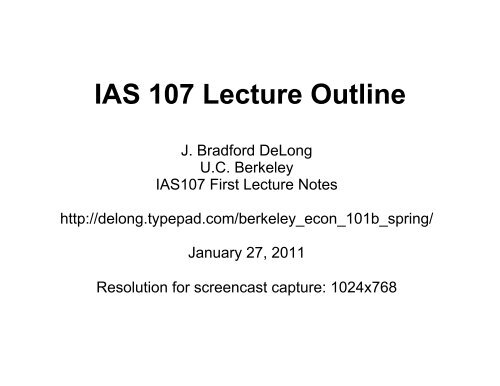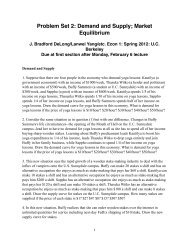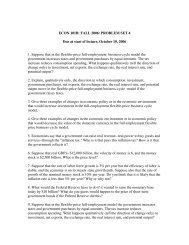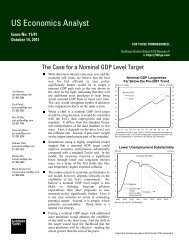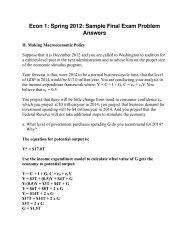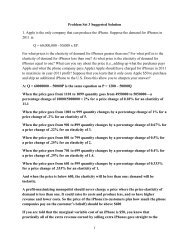20110127_ias 107 upload.pdf - Typepad
20110127_ias 107 upload.pdf - Typepad
20110127_ias 107 upload.pdf - Typepad
You also want an ePaper? Increase the reach of your titles
YUMPU automatically turns print PDFs into web optimized ePapers that Google loves.
IAS <strong>107</strong> Lecture OutlineJ. Bradford DeLongU.C. BerkeleyIAS<strong>107</strong> First Lecture Noteshttp://delong.typepad.com/berkeley_econ_101b_spring/January 27, 2011Resolution for screencast capture: 1024x768
What We Will DoLogisticsWaitlistSectionsOffice hoursProblem setsRecapitulations Global GDP growthUnemployment rateSay's LawApplying growth theoryMore mathCalculating compoundgrowth ratesDivergence The world since 1800Review of our modelModern economic growth starts in1800Accounting for growth on the leadingedgeSavingsPopulationEfficiency of laborAccounting for divergenceThings used to be even worseCommunismPopulationSavingsEfficiency of labor
Logistics: IAS <strong>107</strong>J. Bradford DeLongU.C. BerkeleyIAS<strong>107</strong> First Lecture Noteshttp://delong.typepad.com/berkeley_econ_101b_spring/January 27, 2011Resolution for screencast capture: 1024x768
The Current Situation
Sections...Th 2-3: 228 DwinelleM 10-11: 243 DwinelleM 2-3: 183 DwinelleM 3-4: 251 DwinelleW 1-2: 255 DwinelleW 4-5: 83 Dwinelle
Office Hours... So far two weeks, W 2-4 up in Evans 601 Three people on waitlist Three others That is too few Thinking about adding more office hoursdown here—probably in FSM cafe
Problem Set 2Up at: Due on Th Feb 3 at the beginning of lecture.Also simple and easy to do:
Recapitulations: Things YouReally Should KnowJ. Bradford DeLongU.C. BerkeleyIAS<strong>107</strong> First Lecture Noteshttp://delong.typepad.com/berkeley_econ_101b_spring/January 27, 2011Resolution for screencast capture: 1024x768
#1: Ladies and Gentlemen, toYour i>Clickers... About how much bigger is total world GDPnow than it was 10,000 years ago? A. About 14 times bigger B. About 17000 times bigger C. About 1200 times bigger D. It’s a silly question: you cannot possiblymake such comparisons. E. It’s a silly question: what the answer isdepends on what your tastes and preferencesare, and everybody is different.
#2: Ladies and Gentlemen, toYour i>Clickers...What is the unemployment rate right now?A. 9.4%B. 9.1%C. 6.2%D. 12.3%E. 23.4%
#3: Ladies and Gentlemen, toYour i>Clickers...Why is Say’s Law—Jean-Baptiste Say’s claim back in1803 that if there was deficient demand for some goodsand services there was equal excess demand for others—wrong? A. Because wages are sticky downward B. Because people spend their incomes not just oncurrently-produced goods and services but on financialassets C. Because financial panics disrupt the web of credit onwhich full employment depends D. Because adverse supply shocks render importantpieces of the capital stock valueless Because overinvestment renders important pieces of thecapital stock valueless
Another Word on Say’s LawIn some ways it is a very striking claim...My old teacher Jeff Weintraub sends me a quote from Arrow andHahn, General Competitive Analysis:There is by now a long and fairly imposing line of economistsfrom Adam Smith to the present who have sought to show that adecentralized economy motivated by self-interest and guided byprice signals would be compatible with a coherent disposition ofeconomic resources.... It is important to understand howsurprising this claim must be to anyone not exposed to thetradition. The immediate "common sense" answer to thequestion "What will an economy motivated by individual greedand controlled by a very large number of different agents looklike?" is probably: There will be chaos. That quite a differentanswer has long been claimed true and has indeed permeated theeconomic thinking of a large number of people who are in noway economists is itself sufficient ground for investigating itseriously...
Another Word on Say’s Law IIArrow and Hahn: It is important to understand how surprising thisclaim must be to anyone not exposed to thetradition. The immediate "common sense" answerto the question "What will an economy motivatedby individual greed and controlled by a very largenumber of different agents look like?" is probably:There will be chaos...In some ways the surprising thing is not that Say’sLaw is false, but that it is so close to being true And that even when it is false in theory, a skillfultechnocratic government can make it true enough inpractice for government work...
Why Say’s Law Is FalseJohn Stuart Mill:People don’t just buycurrently-produced goodsand services with theirincomesThey buy and sell financialassets as well: liquid money(cash), savings vehicles(bonds), safety (bonds ofcredit-worthy governments)When there is an excessdemand for these financialassets, then there is deficientdemand for currentlyproducedgoods and services.Businesses then fire workers.
A Fourth Thing You HadBetter LearnHow to use this growth-theory equation todo calculations
A Little More Math...J. Bradford DeLongU.C. BerkeleyIAS<strong>107</strong> Lecture Noteshttp://delong.typepad.com/berkeley_econ_101b_springJanuary 27, 2011Resolution for screencast capture: 1024x768
Calculating Compound GrowthRates If things are easy—i.e., multiples ofdoublings—you canuse the rule of 72... That you shouldkeep in your head... Otherwise, that iswhy the One Who Ismademicroprocessors...
Botswana
But...
Botswana and Zambia Are RightNext to Each Other...
Economic Growth: Why Is theWorld so Divergent?J. Bradford DeLongU.C. BerkeleyIAS<strong>107</strong> Lecture Noteshttp://delong.typepad.com/berkeley_econ_101b_springJanuary 27, 2011Resolution for screencast capture: 1024x768
The World in 1800
The World Today
The World since 1800
The Facts Mammoth increases in wealth since 1800 Mammoth increases in spread since 1800 Countries that stay (relatively) poor(Niger<strong>ias</strong>) Countries that stay (relatively) rich(Americas) Japans Argentinas Countries that switch
The Model Y = K α (EL) 1-αA one-parameter modelWith constant returns to scale in labor and capitalWith diminishing returns to capitalα measures the speed with which returns to capital diminishWith E measuring the efficiency of laborGrowth rates:g for the proportional growth rate of En for the proportional growth rate of Lδ for the depreciation rate on capital Ks for the savings-investment share
From Our SimpleModel...
Our Magic Equation
First, Let’s Look Over Time at What’sHappening on the Leading EdgeModern Economic Growth as we know it starts in1800, or perhaps 1870It could not have been going on long before then
Indeed, Nothing Like Modern EconomicGrowth Is Visible Before 1800English construction workers hired by monks (and guildmasters):
But Starting in 1800 or so...
What Does Our MagicEquation Tell Us?
Accounting for GrowthSince 1800 GDP per capita on the leading edge up by afactor of 20 in the U.S., a factor of 10 in theU.K.... Population growth n down from 3% to 1%per year... Savings-investment shares roughly doubled... How much of this growth can these factorsaccount for?
Accounting for GrowthSince 1800 II Assume a diminishing returns parameter α=1/2... A doubling of savings-investment rates woulddouble output per capita... A fall in population growth rates from 3%/year to1%/year or so would boost output per capita by1/3... Multiply these two together and we account fornearly a tripling of output per capita... We need another factor of 3 (for the U.K.) or of 7(for the U.S.) to explain what is going on at theleading edge
Accounting for GrowthSince 1800 IIICapital intensity accounts for a tripling of output per capita...We need another factor of 3 (for the U.K.) or of 7 (for the U.S.)to explain what is going on at the leading edgeThe efficiency of labor is the place to get itBetter educated workersBetter technologies Apply to the engineering schoolBetter organizationsApply to HaasWhat happened/can we make happen to speed primarilytechnological and secondarily organizational progress?
Second, Let’s Look at a Moment in Timeat the World
Just What the Frack IsGoing On Here? We ship t-shirts in containers from Shanghaito Oakland In fact, we first ship the cotton from LongBeach to Shanghai And then we ship the t-shirt from Shanghai toJakarta And then from Jakarta to Miami Beach And then from Philadelphia to Mombasa Yet this is the world we have
Consolation: ThingsUsed to Be Worse
Why Were ThingsWorse? Communism I
Why Were ThingsWorse? Communism II
Why Were ThingsWorse? Communism III
Among MarketEconomies: Population
Among MarketEconomies: Investment
Even within MarketEconomies... Most of the action is in the efficiency of laborE We have a spread of 20 across the worldtoday And of this differences in investment ratesand population growth rates can account forat most a factor of 4 Leaving a factor of 5 to be accounted for bydifferences in the efficiency of labor—in theapplication of technology and organization


